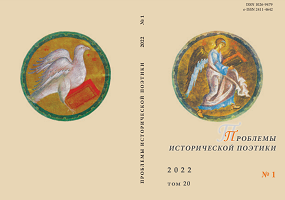Образ детства в рассказах Федора Сологуба
The Image of Childhood in the Short Stories by Fyodor Sologub
Author(s): Irina V Klypina, Elena Yu. ShestakovaSubject(s): Aesthetics, Semantics, Russian Literature, 19th Century
Published by: Петрозаводский государственный университет
Keywords: Fyodor Sologub; image of childhood; image of a child; Russian symbolism; decadence; stories; motif;
Summary/Abstract: The article analyzes the features of the artistic embodiment of the image of childhood in the short stories by Fedor Sologub, a Russian writer of the late 19th — early 20th century. In his works, the author turned to the theme of the tragedy of human earthly existence and the image of a suffering child. The theme of childhood in Sologub’s creative quest is integrated in the context of the leading artistic and aesthetic trends, trends, styles of the turn-of-thecentury period — symbolism, naturalism, decadence. In his short stories, which address children’s images and destinies, Fyodor Sologub assigns a dominant role to symbols. The writer’s works about childhood contain numerous symbolic images that acquire unexpected forms and semantic content. The author delves into the world of children’s consciousness, which is turned towards transcendental, supersensible knowledge. In this regard, Sologub’s short stories are saturated with images of death and motifs of a child’s altered consciousness. The essential features of Fyodor Sologub’s ideas of childhood are determined by the specifics of his philosophical beliefs. The writer’s creative path and his worldview are inextricably linked with the philosophical views of Arthur Schopenhauer and Friedrich Nietzsche. The author’s desire to embody the cult of beauty, death and madness in his works of fiction about children was the result of his fascination with the ideas of German philosophers. The theme of the child hero’s departure from the hardships of earthly reality into the world of dreams, art, beauty, madness, death was prioritized in the writer’s work. The saturation of texts with landscape and color images, which are often juxtaposed, contrasted, was an important setting of the artistic world of Sologub’s short stories about childhood. Color symbolism is extremely significant in the works of the writer, revealing the theme of childhood. The ambiguity and semantic saturation of color imagery endows the short stories about childhood with uniqueness and individuality. The principle of duality, the idea of the supra-world nature of the child-hero, the borderline of his inner worldview was expressed in the writer’s prose devoted to the theme of childhood. The image of a child appearing in the short stories fully reflects the author’s belief in the mystery, uniqueness, and incomprehensibility of the inner world of a little person. The writer felt close to the theme of suffering and humiliation of a child, which first emerged and was fully shaped in the Russian literature of the 19th century.
Journal: Проблемы исторической поэтики
- Issue Year: 20/2022
- Issue No: 1
- Page Range: 254-274
- Page Count: 21
- Language: Russian

